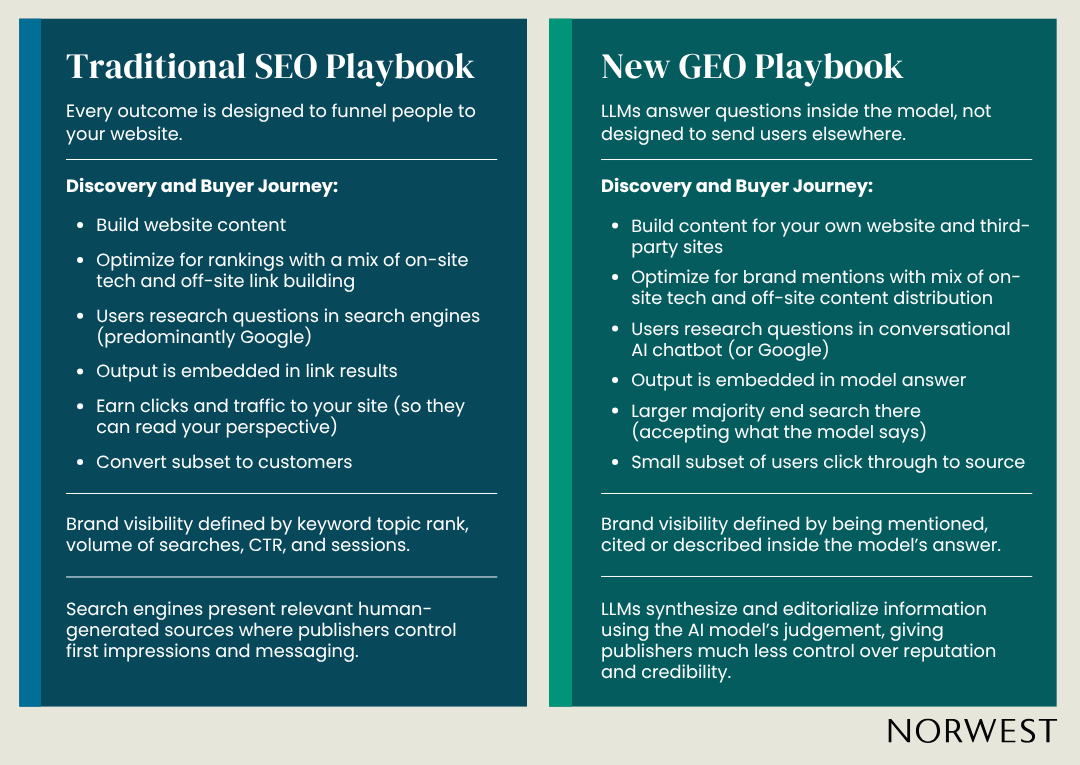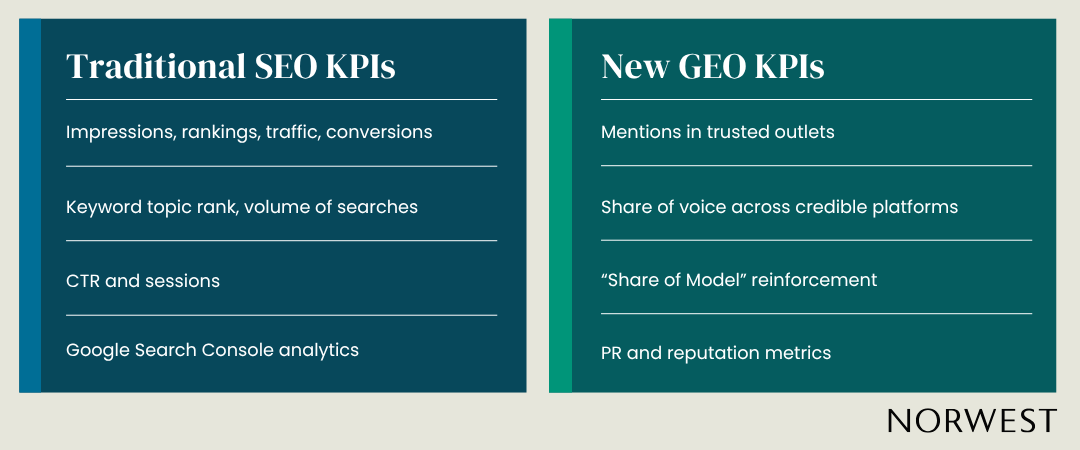Over the past two decades, I’ve led global brand, product marketing, and demand gen strategies, while also working hands-on across nearly every marketing discipline at early-stage startups. Through it all, SEO has remained a constant fixture in the CMO playbook.
That still holds true in my role today as a Principal and Marketing Operating Executive at Norwest, where I work with company leaders to optimize and scale their revenue engines for growth. And yet, as we’ve built out a library of AI resources for our portfolio companies, one question keeps surfacing with strategic implications beyond how to adopt AI into their workflows: what happens to SEO in the age of generative AI?
To test my assumptions and build a deeper perspective, I went straight to traditional SEO experts who are navigating this transition in real time. After a handful of coffee chats and dozens of hours of research, I’m convinced this is not an evolution of a tactic or a channel. GEO is even more urgent for the most senior marketing leaders to understand than I’d originally thought. Here’s what I’m sharing with our portfolio leaders.
For the past 30 years, search engines have been the foundational infrastructure for discovering information on the internet. Indexing and ranking have functioned like digital roadways, and Google’s blue wall of links were the exit signs, showing us the destinations where we’d most likely find our answers.
But LLM assistants like ChatGPT, Perplexity, Claude, and even Google’s own AI Overviews, are collapsing the old model of information discovery.
For the first time in the history of digital marketing, brands are no longer fighting for a click. They’re fighting to be remembered.
The more consistently a brand is mentioned in authoritative contexts, the more likely it is to be pulled into future responses. This is the new reality that CMOs must understand.
The more consistently a brand is mentioned in authoritative contexts, the more likely it is to be pulled into future responses. This is the new reality that CMOs must understand.
The crazy “dance” that digital marketers have done for decades, reverse engineering the Google algorithm, is over. We’re watching the rise of LLMs, but their inner workings are opaque, and there’s not just one model to understand.
Sure, ChatGPT claims 60% of LLM usage, but the other 40% is distributed across various platforms – so marketers can’t write off other models.
Even Google itself is evolving beyond recognition. Nearly half of all search queries now feature AI Overviews. Brands face the same challenge influencing Google’s AI overview snippets as they do with Perplexity, Claude, and ChatGPT.
This reality is creating new user behaviors:
- Users are gravitating toward conversations, not keywords. Traditional Google queries averaged two or three words, but answer engines have flipped this behavior. Users are now more likely to ask full, context-filled questions like “What marketing automation platform should a $50M revenue SaaS company use if they’re migrating from HubSpot and need advanced attribution?”
- Synthesized answers are being treated as trusted consultants. ChatGPT doesn’t rank your content against your competitors. Instead, it creates new content based on training data and multiple sources. SEO strategist Kevin Indig’s research shows that users increasingly treat these responses as final destinations, trusting the synthesis over the source.
Fighting for Visibility Means Driving Influence, Not Clicks.
In the age of generative AI, discoverability is defined by how much trust and authority you’ve built in the digital ecosystem that trains these models. These models summarize consensus and value reputation over recency. As Indig puts it, traditional search “was a reactive environment. Now you have to proactively shape what the models know about you.”
Historically, publishers have always had control. Your content has lived on your domain. Users came to you. Your brand voice remained intact. Your value proposition was presented in your own words. You controlled the context, adjacent content, user experience, and conversion path.
But publishers have lost control. The power has shifted to the synthesizers — the AI models that don’t simply index or rank content, but actively rewrite, combine, and reinterpret it. Your detailed, nuanced blog post about the challenges of enterprise data migration becomes a bullet point in an AI response. Your carefully crafted positioning against competitors gets reduced to a feature comparison. Your thought leadership on industry trends becomes raw material for generic advice.
The power has shifted to the synthesizers — the AI models that don’t simply index or rank content, but actively rewrite, combine, and reinterpret it.
And the kicker? Your brand may not even be mentioned alongside these ideas. This is why SEO tactics won’t be enough — and why CMOs, content teams, PR teams, and digital marketers have to understand how GEO works.
Generative AI platforms determine both if you get found and how you get represented. Users form opinions about your expertise through the AI’s interpretation of your expertise.
The Digital Acquisition Funnel is Morphing.
“We’re watching the traditional buyer’s journey collapse into a single prompt-response moment,” says Andrew Lennon, who has led SEO at Williams-Sonoma, Sephora, and Zendesk.
The demand gen funnel was built on SEO, and that foundation is crumbling. Content marketing, once a way to earn an audience through relevance and authority rather than paid reach, is losing its footing in a world where LLMs decide what (and who) gets seen. These models don’t direct users to other sources — they’ve become the editorial authority.
We have to rebuild from scratch:

How to Build Influence so Answer Engines Remember You…And Cite You.
No, the answer is not to write more blogs. Your new goal is to train the model to cite you. This means ensuring your message shows up where the model learns.
Which function is best positioned to do this? PR. Fine-tuning messaging, earning trust, and building credibility have always been PR’s bread and butter. With mentions becoming the new currency for LLM recalls, your SEO strategy is shifting from technical to PR-focused. You’re not focused on link building. You’re focused on getting others to talk about you.
To get started, teams should invest in building education and strategy around three areas:
- Understanding model memory inputs. Training data comes from Common Crawl, Wikipedia, Reddit, news articles, and product documentation. Fine-tuning happens through brand citations in structured datasets, press coverage, and Q&A sites.
- Knowing which sources LLMs trust. BCG reports that Wikipedia has been cited 1.3M times by ChatGPT. Other heavily cited sources include G2, Forbes, Reddit, Amazon, Capterra, WSJ, and TechCrunch. Brand-owned content carries less weight unless it is cited or linked from these trusted platforms. As Jim Yu, the Founder and CEO of enterprise SEO and content platform BrightEdge explains, “If your brand isn’t cited in respected outlets, you may be invisible to the model even if your site ranks well in Google.”
- Recognizing how repetition compounds recall. “Repetition across trusted sources boosts model recall,” Seth Besmertnik, CEO of AI search visibility platform, Conductor, shared with me during a conversation. The more a brand is mentioned across prompts, the more likely it is to appear again — a self-reinforcing loop or what some call “prompt reinforcement bias” or the “Share of Model” advantage.
Search Has Flipped From a Click Economy to a Visibility Economy. How Do You Measure Success?
Measuring success in this new landscape looks very different:

For marketing leaders accustomed to precise SEO ROI tracking, this shift feels uncomfortably squishy. The formula to get it right always felt like part art and science, but Google Search Console and platforms like Ahrefs and SEMRush made it easy to measure SEO performance and connect it back to search trends, topics, sources, impressions, content, and conversion rates. Much of the performance was within your own control. You authored the content. You owned the web properties where the content was hosted.
Now these traditional SEO measurement models are showing steep declines in non-branded search traffic, but that’s only half the story. They don’t account for AI-driven influence. A user may encounter your brand in a synthesized response and convert days later through a direct website visit, or they may add your name to an analyst inquiry after seeing it in an AI recommendation. The model acts as the influencer, yet its role never shows up in dashboards.
Even worse, users may not encounter your brand at all. As Indig explains, “If you’re not already in the conversation around a topic, the model doesn’t know to mention you.” More importantly, you need to understand where these conversations are unfolding and make sure your brand shows up in the sources LLMs learn from most.
The brands that earn a place in AI memory today will enjoy first-mover advantage — and it may be lasting. Once embedded in the model’s recall, those brands may become part of its baseline narrative – making them difficult to dislodge and harder to compete against.
The shift from SEO to GEO breaks the inbound marketing playbook entirely. CMOs who move first to write the strategy for what comes next will shape how their brands are remembered in the age of AI.
Join our webinar Generative Engine Optimization: AI’s New Frontier of Brand Visibility on Tuesday, October 22 at 8:30am PT.




